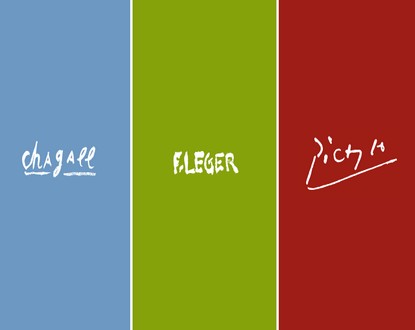At the Marc Chagall National Museum – Nice: exhibition presented from November 19, 2011 to January 30, 2012. At the Fernand Léger National Museum – Biot: exhibition presented from December 3, 2011 to March 5, 2012.
The exhibition “Mais quel cirque!” Chagall and Léger in the land of circles in action, organized by the national museums of the 20th century in the Alpes-Maritimes, is presented in two parts at the Marc Chagall National Museum and the Fernand Léger National Museum.
It highlights the fascination of the two artists for this spectacle that became very popular since the second half of the 19th century and which is a recurring source of inspiration in their work.
“Mais quel cirque!” Chagall would say when Léger proposed, “Go to the circus. You leave your rectangles, your geometric windows, and you go to the land of circles in action.”
From Degas to Picasso, including Toulouse-Lautrec, Renoir, Rouault, Matisse, or Calder, the world of the circus has had a major influence on the artistic avant-garde since Impressionism. The analogy between the round shape of the arena and that of the earth illustrates the metaphor of the artists’ perspective on our modern world. As a precursor to mass leisure, the circus becomes an attraction for everyone, young and old, workers and aristocrats alike.
“The circus was the event of my childhood, and now it has returned to my painting,” Fernand Léger confided at the end of his life. “I imagined my circus in the nighttime hours. It is in the middle of my room. You can hear the laughter and the shouts,” wrote Marc Chagall.
Despite different approaches, Chagall and Léger share the commonality of having drawn many figures from the circus universe. From his series “Contrasts of Forms” before the Great War, Léger developed a plastic writing style capable of capturing the whirlwind of modern life through the contrasting effects of lines and colors.
At the end of his life, he remembered the popular excitement caused by the arrival of the circus from his Norman childhood in Argentan. Accompanied by his poet, writer, painter, and musician friends such as Blaise Cendrars, Guillaume Apollinaire, Darius Milhaud, Max Jacob, or Robert Delaunay, he frequently attended the Medrano Circus and the Fratellini clown trio.
For his part, Marc Chagall was attracted by the world of the traveling circus and musicians that reminded him of his Jewish childhood in Vitebsk, Russia. The magic of colors and sounds served as a medium for poetic creation. For him, the acrobat is an allegory of the artist, and he cultivates this theme as a metaphor for life.
Around the artist books published by Tériade at Verve editions in 1950 for Léger and in 1967 for Chagall, the exhibition gathers a selection of studies, preparatory gouaches, handwritten or printed pages. Thanks to the original copies of the book “Cirque” offered in 1969 by Nadia Léger and Georges Bauquier and in 1995 by Alice Tériade, the widow of the publisher, the Fernand Léger National Museum presents the work fully displayed.
This event offers the rare opportunity to admire a masterpiece of 20th-century art bibliophilia. It is accompanied by a collection of paintings, drawings, and ceramics on the theme of the circus from the collection and on loan.
At the Marc Chagall National Museum, 38 gouaches from a private collection are presented. Painted by the artist in 1955, they illustrate ten years later the collection of his texts on the circus published by Tériade. Finally, loans from the Alain Frère collection allow the fascinating universe of the arena to be evoked through costumes, photographs, and posters, a source of entertainment for the public and inspiration for our artists.


